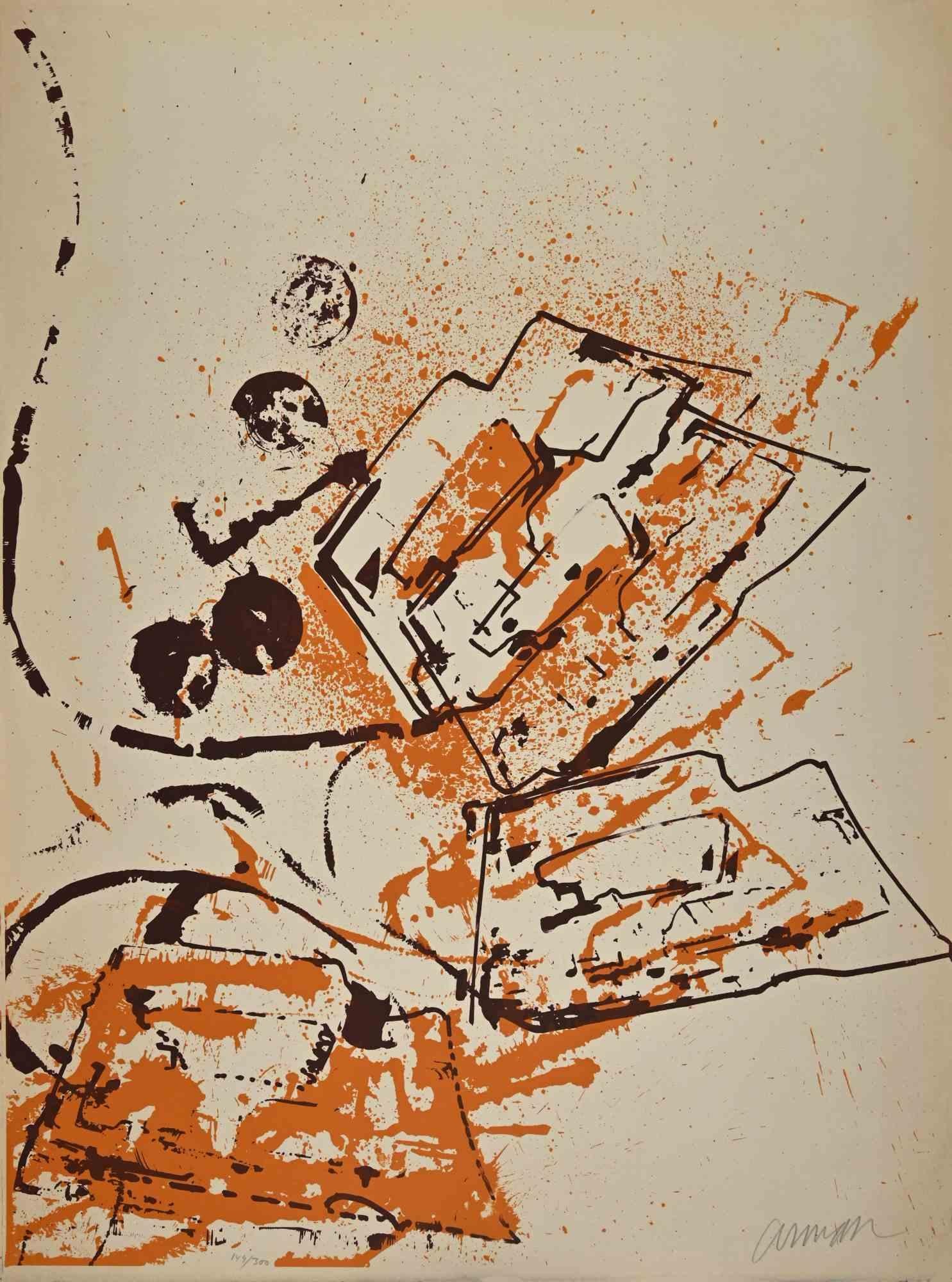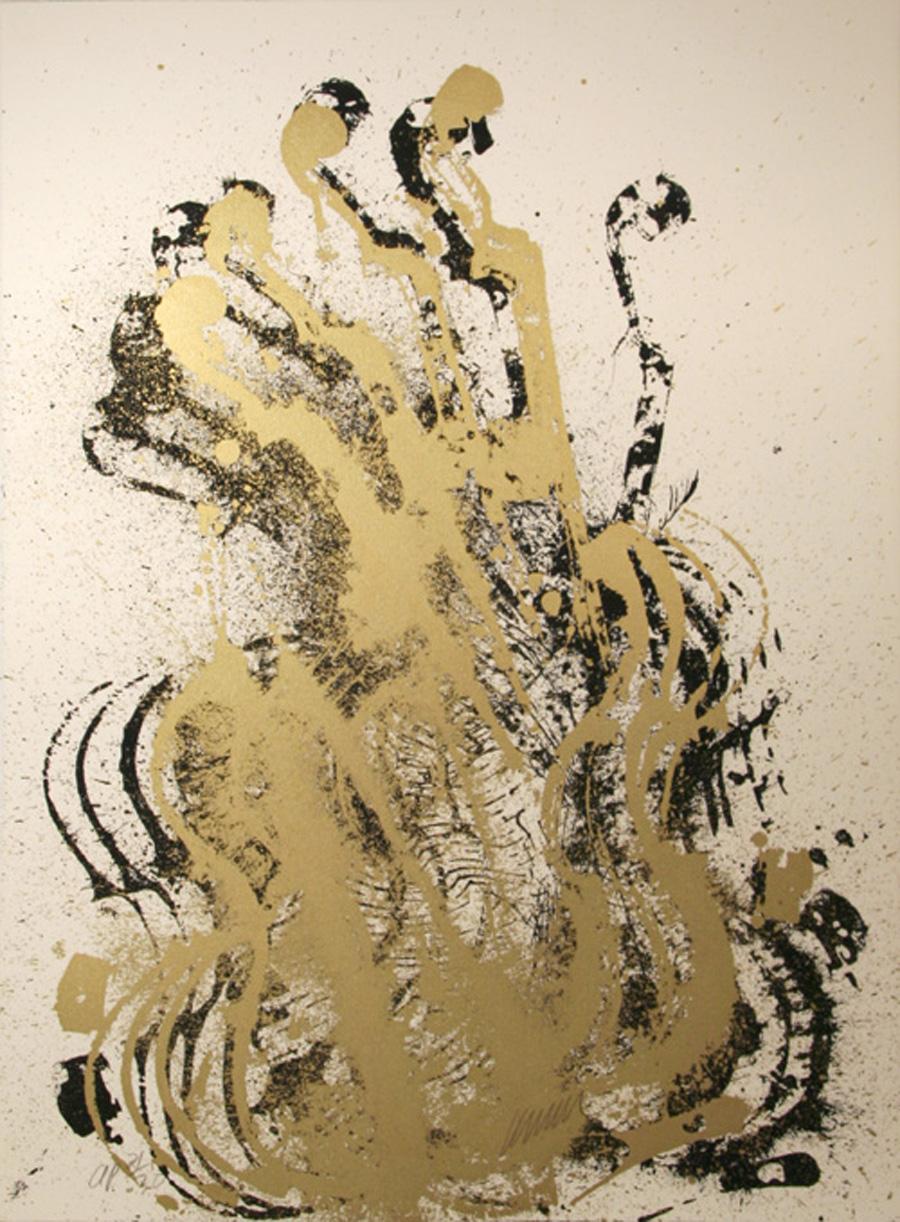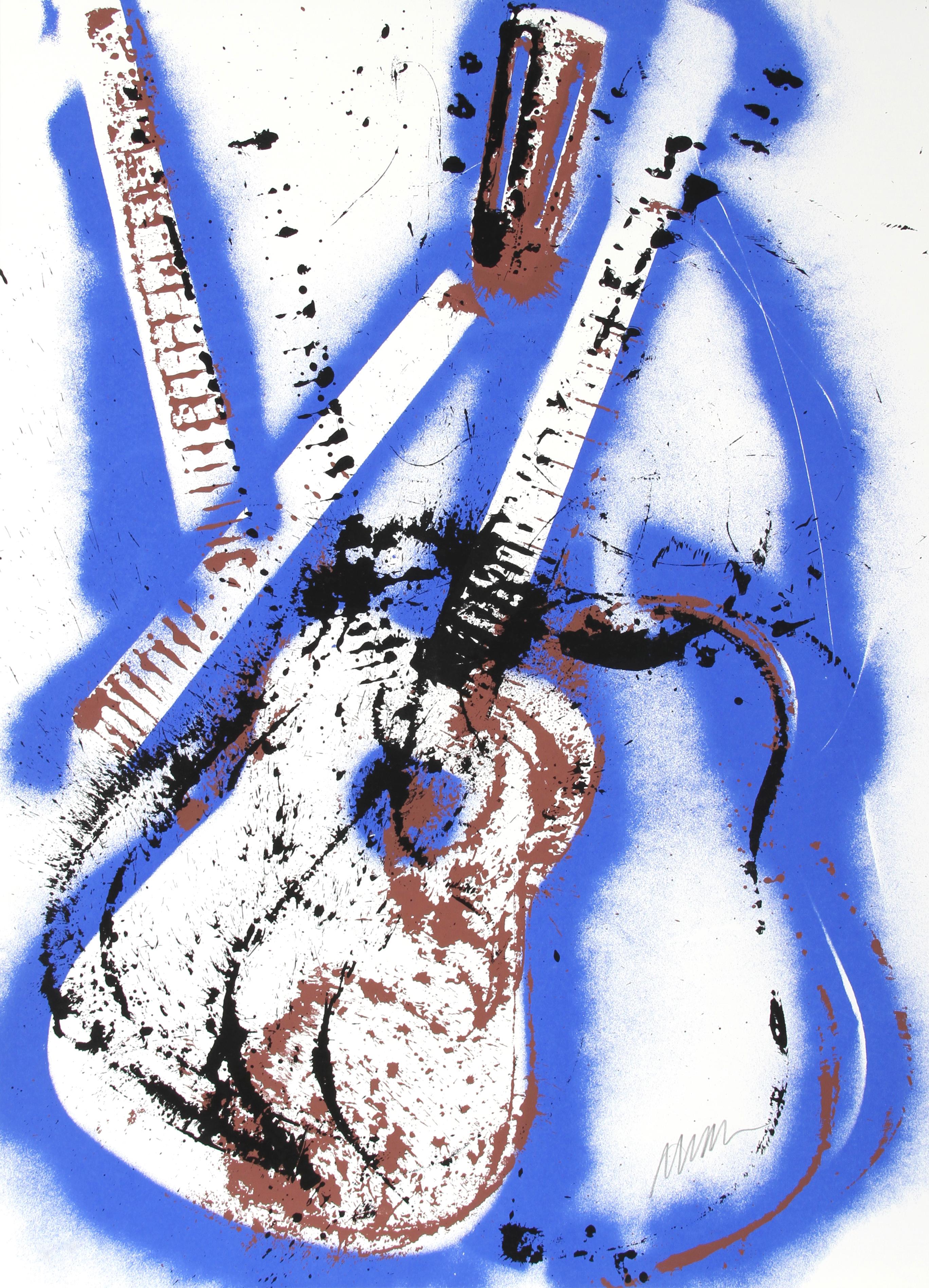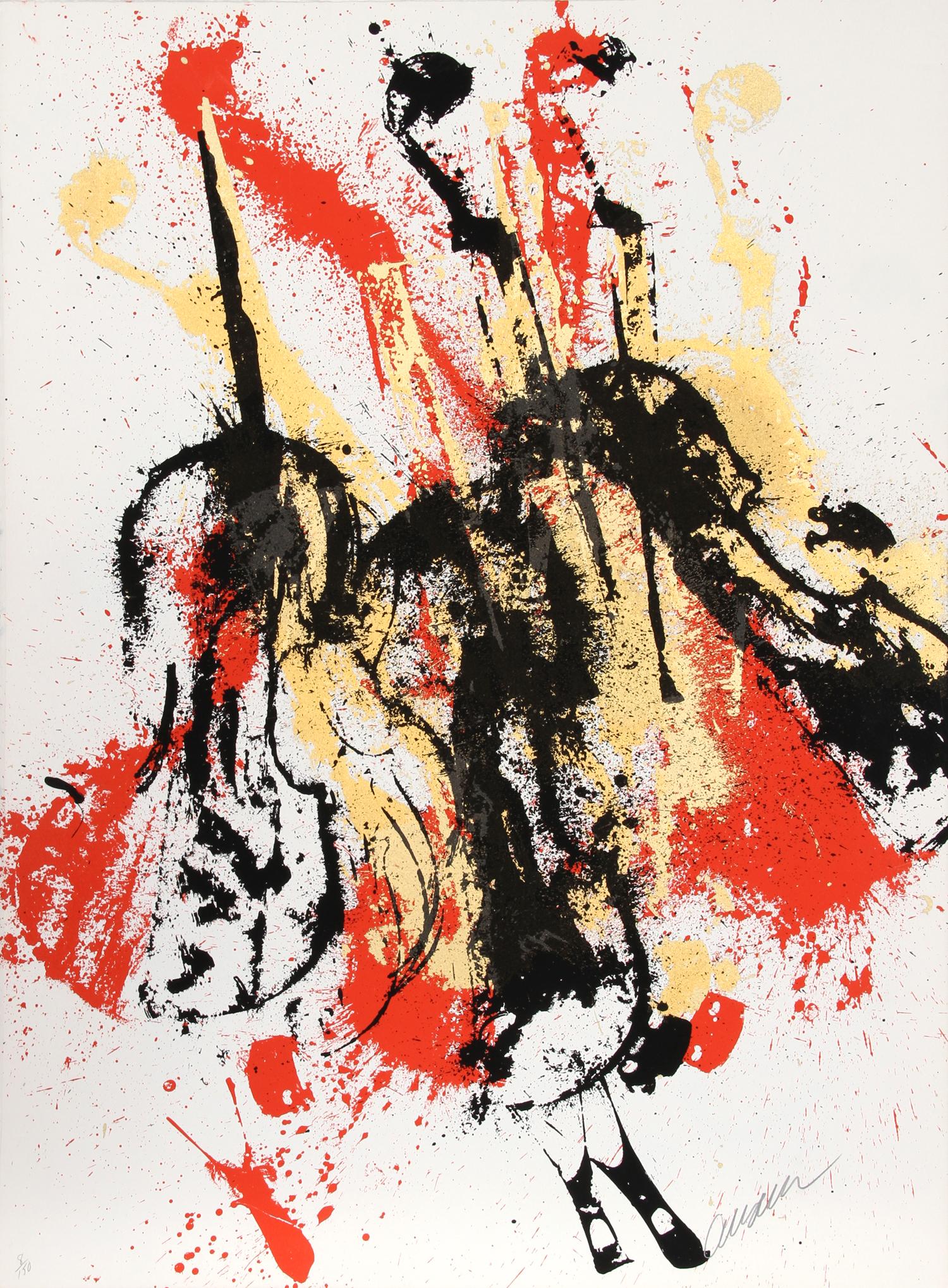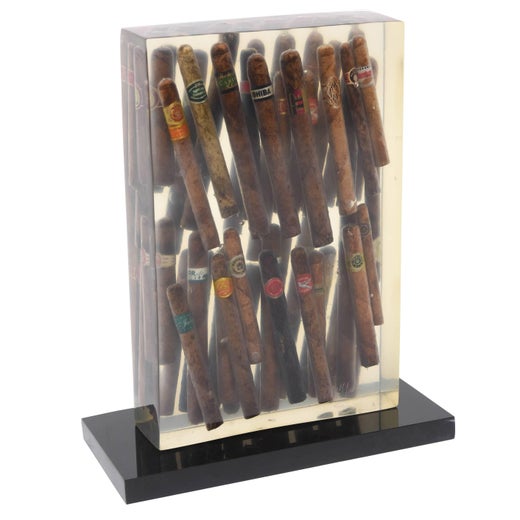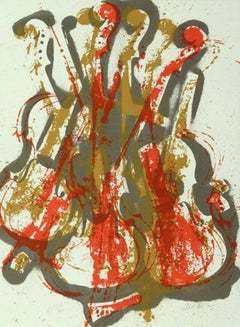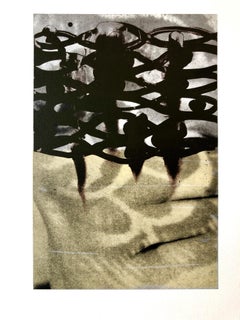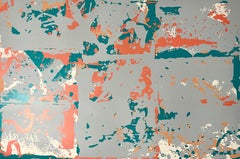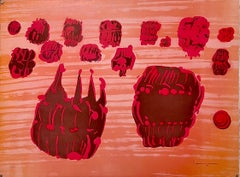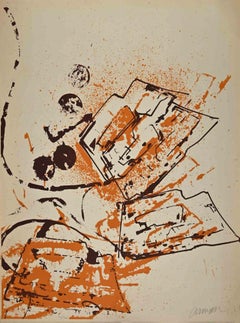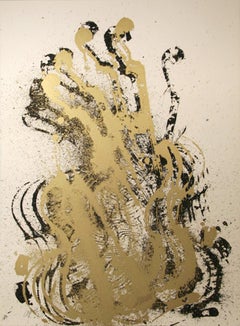Items Similar to Le masque à gaz, Gas Mask Hand Signed Lithograph Silkscreen
Want more images or videos?
Request additional images or videos from the seller
1 of 5
ArmanLe masque à gaz, Gas Mask Hand Signed Lithograph Silkscreen1971
1971
$1,200
£919.95
€1,052.68
CA$1,695.87
A$1,843.34
CHF 986.77
MX$22,281.76
NOK 12,435.25
SEK 11,468.53
DKK 7,861.87
About the Item
Le masque à gaz, 1971, edition of 300. Signed "Arman" in pencil l.r., numbered in pencil l.l. Lithograph in purple and gold on paper, image size 25 3/8 x 19 3/8 in. (64.3 x 49.0 cm), framed.
Condition: Deckled edges, subtle rippling, gentle toning to the edges of the sheet,
Arman (November 17, 1928 – October 22, 2005) was a French-born American artist. Born Armand Fernandez in Nice, France, Arman was a painter who moved from using objects for the ink or paint traces they leave (cachet allures d'objet) to using them as the painting itself. He is best known for his accumulations and destruction/recomposition of objects. From his father, Arman learned oil painting and photography. After receiving his bachelor's degree in philosophy and mathematics in 1946, Arman began studying at the École Nationale des Arts Décoratifs in Nice. He also started judo at a police school in Nice where he met Yves Klein and Claude Pascal. The trio bonded closely on a subsequent hitch-hiking tour around Europe.
Early on, it was apparent that Arman's concept of the accumulation of vast quantities of the same objects was to remain a significant component of his art. Ironically, he had originally focused more attention on his abstract paintings, considering them to be of more consequence than his early accumulations of stamps. Only when he witnessed viewer reaction to his first accumulation in 1959 did he fully recognize the power of such art. In 1962, he began welding together accumulations of the same kinds of metal objects, such as axes
Inspired by an exhibition for the German Dadaist Kurt Schwitters in 1954, Arman began working on "Cachets," his first major artistic undertaking. At his third solo exhibition held in Paris's Galerie Iris Clert in 1958, Arman showed some of his first 2D accumulations he called "cachets." These stamps on paper and fabric proved a success and provided an important change of course for the young artist's career.
At the time, he was signing with his first name as an homage to Van Gogh, who also signed his works with his first name, Vincent. And, thus, in 1957, Arman chose to change his name from Armand to Arman. On January 31, 1973, upon becoming a citizen of the United States, he took the American civil name, Armand Pierre Arman. Nevertheless, he continued to use "Arman" as his public persona.
In October 1960, Arman, Yves Klein, François Dufrêne, Raymond Hains, Martial Raysse, Daniel Spoerri, Jean Tinguely and Jacques Villeglé, and art critic and philosopher Pierre Restany founded the Nouveau réalisme group. Joined later by Cesar, Mimmo Rotella, Niki de Saint Phalle, and Christo, the group of young artists defined themselves as bearing in common their "new perspective approaches of reality." They were reassessing the concept of art and the artist for a 20th-century consumer society by reasserting the humanistic ideals in the face of industrial expansion.
Arman can be seen in Andy Warhol's film Dinner at Daley's, a documentation of a dinner performance by the Fluxus artist Daniel Spoerri that Warhol filmed on March 5, 1964. Throughout the portrait-screen-test film, Arman sits in profile, looking down, appearing to be entranced in his reading, seemingly unaware of Warhol's camera, only making small gestures, rubbing his eyes, and licking the corner of his mouth. He remained silent, eyes gazing over the pages of what seemed to be a newspaper, in this four-minute, 16mm black-and-white reel. Warhol owned two of Arman's Poubelles and another accumulation called Amphetamines, which were sold at Sotheby's auction of the Andy Warhol Collection in May 1988.
Fascinated with the scene in New York, Arman took up part-time residency there from his home in Nice in 1961, after his first exhibition at the Cordier Warren Gallery. In the city, he met Marcel Duchamp at a dinner given by the artist and collector William Copley.
Selected exhibitions and awards
Arman, Stedelijk Museum, Amsterdam, Holland
Arman, Walker Art Center, Minneapolis, Minnesota
Arman, Palazzo Grassi, Venice, Italy
Musée des Arts Decoratifs, Paris, France; *Louisiana Museum of Modern Art Arman, Modern Art Museum, Stockholm, Sweden
Arman, Artcurial auction house, Paris, France
Arman: A Retrospective 1955 - 1991, The Brooklyn Museum, Brooklyn, New York; The Detroit Institute of Art, Detroit, Michigan
Arman, Musée du Jeu de Paume, Paris, France
Arman, Tel Aviv Museum of Art, Israel
Arman: Arman, Museum of Contemporary Art of Teheran, Teheran, Iran
Arman, Marlborough New York City
Arman, a retrospective, Centre Georges Pompidou, Oct. 2010, Paris
Arman, retrospectve, Museum Tinguely, Feb. 2011, Basel, Switzerland
Arman-in les Baux de Provence, July-Oct. 2011, Les Baux-de-Provence
Paul Kasmin Gallery, New York
Public collections in the U.S.A., selected
Fine Arts Museums of San Francisco, California
Hirshhorn Museum and Sculpture Garden, Washington, D.C.
Harvard Art Museum, Cambridge, Massachusetts
The Detroit Institute of Arts, Detroit, Michigan
The Museum of Modern Art, New York
- Creator:Arman (1928 - 2005, French)
- Creation Year:1971
- Dimensions:Height: 25.38 in (64.47 cm)Width: 19.38 in (49.23 cm)
- Medium:
- Movement & Style:
- Period:
- Condition:subtle rippling, gentle toning to the edges of the sheet,.
- Gallery Location:Surfside, FL
- Reference Number:1stDibs: LU38212292932
Arman
Arman was born in Nice, France, in 1928, and showed a talent for painting and drawing as a child. He studied at the the Ecole Nationale des Art Décoratifs in Nice followed by studies at the École du Louvre in Paris. In his early years he focused on abstract paintings. Then, in 1957, he became interested in common objects as works of art. He first did what came to be called his "allures d"objet" (object impressions), where he would dip an object into paint and press it on canvas thus leaving the object's shadow or impression. Then he decided the object itself was worth paying attention to and started to treat them in his own way. His intention was to remove the material purpose of an object so that its only remaining function was to "feed the mind" as a work of art. What better way to achieve that result than by breaking, slicing or even burning objects such as violins, telephones, typewriters or even whole cars? He also made objects useless by accumulating them, such as 2,000 wristwatches in a Plexiglass box that all kept different time. Once emotionally detached from the circumstances associated with a broken object, the viewer could grow to appreciate its abstract beauty; so, in a sense, Arman was literally teaching that things one never thought could be regarded as attractive could indeed turn out to be so. Through this achievement, Arman gained worldwide recognition and is regarded as one of the most prolific and inventive creators of the late 20th century. His work can be found in the collections of numerous museums including the Metropolitan Museum of Art in New York, the Tate Gallery in London and the Centre Pompidou in Paris. Arman’s work has also been exhibited in galleries, museums and public spaces worldwide including the Musée D’Art Contemporain in Tehran, Iran; the Museum of Art in Tel Aviv, Israel; the Musée Des Arts Decoratifs and Opéra De Paris in France; the La Jolla Museum of Contemporary Art in California; and the Museum of Arts and Design and the Guggenheim in New York He died in 2005 in New York.
About the Seller
4.9
Platinum Seller
Premium sellers with a 4.7+ rating and 24-hour response times
Established in 1995
1stDibs seller since 2014
1,843 sales on 1stDibs
Typical response time: 1 hour
- ShippingRetrieving quote...Shipping from: Surfside, FL
- Return Policy
More From This Seller
View AllViolent Violin Concerto Hand Signed Lithograph Silkscreen
By Arman
Located in Surfside, FL
Arman (November 17, 1928 – October 22, 2005) was a French-born American artist. Born Armand Fernandez in Nice, France, Arman was a painter who moved from using objects for the ink or...
Category
1970s Abstract Abstract Prints
Materials
Lithograph
Set of Eyes, Color Lithograph, Belgian Abstract Expressionist Tamarind Print
By Dirk de Bruycker
Located in Surfside, FL
Signed, dated and titled. Initialed and dated lower right, each numbered 8/20, lower left. 9 x 6 image size, 22 x 15 in. sheet size. With the blindstamp of the Tamarind Institute pri...
Category
1990s Abstract Expressionist Abstract Prints
Materials
Archival Paper, Lithograph
Large Mandragora Abstract Expressionist Screenprint Lithograph Darby Bannard
By Walter Darby Bannard
Located in Surfside, FL
Walter Darby Bannard (born 1934 in New Haven, CT)
Mandragora
Silkscreen Litho print on BFK Rives art Paper. Hand signed in pencil, numbered and titled.
Walter Darby Barnard is a Pr...
Category
1980s Abstract Abstract Prints
Materials
Mixed Media
Pietro Consagra Italian Mod Abstract Expressionist Forma Brutalist Lithograph
By Pietro Consagra
Located in Surfside, FL
Pietro Consagra (Italian, 1920-2005).
Hand signed in pencil and numbered limited edition color lithograph on Magnani paper.
Embossed stamp with limited edition numbers in pencil to lower left, and having artist pencil signature to lower right.
(from a limited edition of 80 with 15 artist's proofs)
Published by Stamperia 2RC, Rome Italy and Marlborough Gallery, Rome, Italy.
Abstract Modernist work in colors, produced in the style of the Forma art movement of Postwar Italy, of which the artist was a prominent member.
Pietro Consagra (1920 – 2005) was an Italian Post war artist working in painting, printmaking and sculpture. In 1947 he was among the founding members of the Forma 1 group of artists, proponents of structured abstraction.
Consagra was born on 6 October 1920 in Mazara del Vallo, in the province of Trapani in south-western Sicily, to Luigi Consagra and Maria Lentini. From 1931 he enrolled in a trade school for sailors, studying first to become a mechanic, and later to become a captain. In 1938 he moved to Palermo, where he enrolled in the liceo artistico; despite an attack of tuberculosis, he graduated in 1941, and in the same year signed up at the Accademia di Belle Arti, where he studied sculpture under Archimede Campini. After the Invasion of Sicily and the Allied occupation of Palermo in 1943, Consagra found work as a caricaturist for the American Red Cross club of the city; he also joined the Italian Communist Party. Early in 1944, armed with a letter of introduction from an American officer, he travelled to Rome. There he came into contact with the Sicilian artist Concetto Maugeri, and through him with Renato Guttuso, who was also Sicilian and who introduced him to the intellectual life of the city and to other postwar artists such as Leoncillo Leonardi, Mario Mafai and Giulio Turcato. Consagra signed up at the Accademia di Belle Arti di Roma in September 1944 and studied sculpture there under Michele Guerrisi, but left before completing his diploma.
In 1947, with Carla Accardi, Ugo Attardi, Piero Dorazio, Mino Guerrini, Achille Perilli, Antonio Sanfilippo and Giulio Turcato, Consagra started the artist's group Forma 1, which advocated both Marxism and structured abstraction.
Steadily Consagra's work began to find an audience. Working primarily in metal, and later in marble and wood, his thin, roughly carved reliefs, began to be collected by Peggy Guggenheim and other important patrons of the arts. He showed at the Venice Biennale eleven times between 1950 and 1993, and in 1960 won the sculpture prize at the exhibition. During the 1960s he was associated with the Continuità group, an offshoot of Forma I, and in 1967 taught at the School of Arts in Minneapolis. Large commissions allowed him to begin working on a more monumental scale, and works of his were installed in the courtyard of the Foreign Ministry in Rome and in the European Parliament, Strasbourg. His work is found in the collections of The Tate Gallery, London, in Museo Cantonale d'Arte of Lugano and the Museum of Modern Art, Paris, and the National Gallery of Art in Washington, D.C..
Consagra returned to Sicily where he sculpted a number of significant works during the 1980s. With Senator Ludovico Corrao, he helped created an open-air museum in the new town of Gibellina, after the older town had been destroyed in the earthquake of 1968. Consagra designed the gates to the town's entrance, the building named "Meeting" and the gates to the cemetery, where he was later buried.
In 1952 Consagra published La necessità della scultura ("the need for sculpture"), a response to the essay La scultura lingua morta ("sculpture, a dead language"), published in 1945 by Arturo Martini. Other works include L'agguato c'è ("the snare exists", 1960), and La città frontale ("the frontal city", 1969). His autobiography, Vita Mia, was published by Feltrinelli in 1980. In 1989 a substantial retrospective exhibition of work by Consagra was shown at the Galleria Nazionale d'Arte Moderna in Rome; in 1993 a permanent exhibition of his work was installed there. In 1991 his work was shown in the Hermitage Museum in St. Petersburg. In 2002 the Galerie der Stadt Stuttgart opened a permanent exhibition of his work. He was one of ten artists invited by Giovanni Carandente, along with David Smith, Alexander Calder, Arnaldo Pomodoro, Lynn Chadwick, and Beverly Pepper, to fabricate works in Italsider factories in Italy for an outdoor exhibition, "Sculture nella città", held in Spoleto during the summer of 1962. He was included in the The 1962 International Prize for Sculpture the jury included Argan, Romero Brest and James Johnson Sweeney the former director of the Solomon R. Guggenheim Museum in New York. The participants included Louise Nevelson and John Chamberlain for the United States; Lygia Clark for Brazil; Pietro Consagra, Lucio Fontana, Nino Franchina, and Gió Pomodoro for Italy; Pablo Serrano for Spain; and Eduardo Paolozzi, William Turnbull, and Kenneth Armitage for England. Gyula Kosice, Noemí Gerstein...
Category
1960s Abstract Expressionist Abstract Prints
Materials
Lithograph
Pietro Consagra Italian Mod Abstract Expressionist Forma Art Informel Lithograph
By Pietro Consagra
Located in Surfside, FL
Pietro Consagra (Italian, 1920-2005).
Hand signed in pencil and numbered limited edition color lithograph on Magnani paper.
Embossed stamp with limited edition numbers in pencil to lower left, and having artist pencil signature to lower right.
(from a limited edition of 80 with 15 artist's proofs)
Published by Stamperia 2RC, Rome Italy and Marlborough Gallery, Rome, Italy.
Abstract Modernist work in colors, produced in the style of the Forma art movement of Postwar Italy, of which the artist was a prominent member.
Pietro Consagra (1920 – 2005) was an Italian Post war artist working in painting, printmaking and sculpture. In 1947 he was among the founding members of the Forma 1 group of artists, proponents of structured abstraction. (similar to the Art Informel and Art Brut in France and the Brutalist artists)
Consagra was born on 6 October 1920 in Mazara del Vallo, in the province of Trapani in south-western Sicily, to Luigi Consagra and Maria Lentini. From 1931 he enrolled in a trade school for sailors, studying first to become a mechanic, and later to become a captain. In 1938 he moved to Palermo, where he enrolled in the liceo artistico; despite an attack of tuberculosis, he graduated in 1941, and in the same year signed up at the Accademia di Belle Arti, where he studied sculpture under Archimede Campini. After the Invasion of Sicily and the Allied occupation of Palermo in 1943, Consagra found work as a caricaturist for the American Red Cross club of the city; he also joined the Italian Communist Party. Early in 1944, armed with a letter of introduction from an American officer, he travelled to Rome. There he came into contact with the Sicilian artist Concetto Maugeri, and through him with Renato Guttuso, who was also Sicilian and who introduced him to the intellectual life of the city and to other postwar artists such as Leoncillo Leonardi, Mario Mafai and Giulio Turcato. Consagra signed up at the Accademia di Belle Arti di Roma in September 1944 and studied sculpture there under Michele Guerrisi, but left before completing his diploma.
In 1947, with Carla Accardi, Ugo Attardi, Piero Dorazio, Mino Guerrini, Achille Perilli, Antonio Sanfilippo and Giulio Turcato, Consagra started the artist's group Forma 1, which advocated both Marxism and structured abstraction.
Steadily Consagra's work began to find an audience. Working primarily in metal, and later in marble and wood, his thin, roughly carved reliefs, began to be collected by Peggy Guggenheim and other important patrons of the arts. He showed at the Venice Biennale eleven times between 1950 and 1993, and in 1960 won the sculpture prize at the exhibition. During the 1960s he was associated with the Continuità group, an offshoot of Forma I, and in 1967 taught at the School of Arts in Minneapolis. Large commissions allowed him to begin working on a more monumental scale, and works of his were installed in the courtyard of the Foreign Ministry in Rome and in the European Parliament, Strasbourg. His work is found in the collections of The Tate Gallery, London, in Museo Cantonale d'Arte of Lugano and the Museum of Modern Art, Paris, and the National Gallery of Art in Washington, D.C..
Consagra returned to Sicily where he sculpted a number of significant works during the 1980s. With Senator Ludovico Corrao, he helped created an open-air museum in the new town of Gibellina, after the older town had been destroyed in the earthquake of 1968. Consagra designed the gates to the town's entrance, the building named "Meeting" and the gates to the cemetery, where he was later buried.
In 1952 Consagra published La necessità della scultura ("the need for sculpture"), a response to the essay La scultura lingua morta ("sculpture, a dead language"), published in 1945 by Arturo Martini. Other works include L'agguato c'è ("the snare exists", 1960), and La città frontale ("the frontal city", 1969). His autobiography, Vita Mia, was published by Feltrinelli in 1980. In 1989 a substantial retrospective exhibition of work by Consagra was shown at the Galleria Nazionale d'Arte Moderna in Rome; in 1993 a permanent exhibition of his work was installed there. In 1991 his work was shown in the Hermitage Museum in St. Petersburg. In 2002 the Galerie der Stadt Stuttgart opened a permanent exhibition of his work. He was one of ten artists invited by Giovanni Carandente, along with David Smith, Alexander Calder, Arnaldo Pomodoro, Lynn Chadwick, and Beverly Pepper, to fabricate works in Italsider factories in Italy for an outdoor exhibition, "Sculture nella città", held in Spoleto during the summer of 1962. He was included in the The 1962 International Prize for Sculpture the jury included Argan, Romero Brest and James Johnson Sweeney the former director of the Solomon R. Guggenheim Museum in New York. The participants included Louise Nevelson and John Chamberlain for the United States; Lygia Clark for Brazil; Pietro Consagra, Lucio Fontana, Nino Franchina, and Gió Pomodoro for Italy; Pablo Serrano for Spain; and Eduardo Paolozzi, William Turnbull, and Kenneth Armitage for England. Gyula Kosice, Noemí Gerstein...
Category
1960s Abstract Expressionist Abstract Prints
Materials
Lithograph
Violent Violin Concerto Hand Signed Lithograph Silkscreen
By Arman
Located in Surfside, FL
Arman (November 17, 1928 – October 22, 2005) was a French-born American artist. Born Armand Fernandez in Nice, France, Arman was a painter who moved from using objects for the ink or...
Category
1970s Abstract Abstract Prints
Materials
Lithograph
You May Also Like
New Romanticism, Abstract Pop Art Screenprint by Arman
By Arman
Located in Long Island City, NY
Artist: Arman, French (1929 - 2005)
Title: New Romanticism
Year: circa 1979
Medium: Screenprint, signed and numbered in pencil
Edition: 150, AP 30
Size: 30 in. x 22 in. (76.2 c...
Category
1970s Dada Figurative Prints
Materials
Screen
Abstract Composition - Lithograph by Arman - 1980s
By Arman
Located in Roma, IT
Abstract Composition is a contemporary artwork realized by the French Artist Arman (Armand Pierre Fernandez) in 1980s.
Mixed colored lithograph on paper. Hand signed on the lower ri...
Category
1980s Abstract Abstract Prints
Materials
Lithograph
Cavalcade, Signed Abstract Screenprint by Arman
By Arman
Located in Long Island City, NY
Artist: Arman
Title: Cavalcade
Year: 1979
Medium: Silkscreen on Arches, signed and numbered in pencil
Edition: 150, AP 30
Paper Size: 25 x 39 inches
Category
1970s Pop Art Still-life Prints
Materials
Screen
Viola d'Amour, Signed Pop Art Screenprint by Arman
By Arman
Located in Long Island City, NY
Artist: Arman
Title: Viola d'Amour
Year: 1978
Medium: Silkscreen on Arches, Signed and Numbered in Pencil
Edition: 150, AP 30
Paper Size: 30 in. x 22 in. (76.2 cm x 55.88 cm)
Printer...
Category
1970s Conceptual Figurative Prints
Materials
Screen
Flamenco, Pop Art Screenprint by Arman
By Arman
Located in Long Island City, NY
Artist: Arman, French (1929 - 2005)
Title: Flamenco
Year: Circa 1980
Medium: Serigraph, signed and numbered in pencil
Edition: 150, HC 10
Size: 41 in. x 29.5 in. (104.14 cm x 7...
Category
1970s Abstract Expressionist Abstract Prints
Materials
Screen
Homage to Vivaldi, Musical Abstract Pop Art Screenprint by Arman
By Arman
Located in Long Island City, NY
This print of a violin replicated several times in black and red across the composition is indicative of Arman's classic technique of recomposition. Transferring the image across the...
Category
1970s Dada Still-life Prints
Materials
Screen
